#Jazz history
Explore tagged Tumblr posts
Text
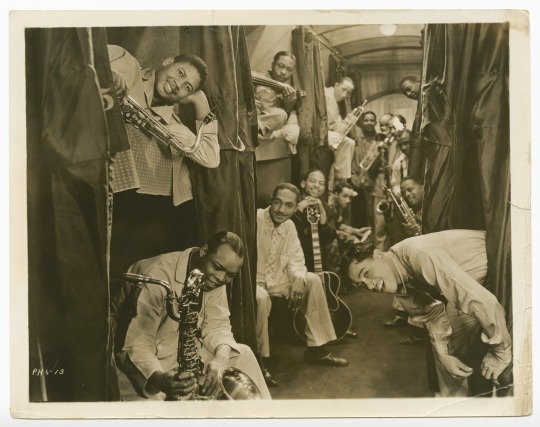
Cab Calloway and his band in a sleeper car, 1933
#Cab Calloway#musicians#photographs#jazz history#1930s#20th century#great depression#gelatin silver prints#american#north america#Harlem renaissance
240 notes
·
View notes
Text


TODAY’S FROZEN MOMENT - 65th Anniversary
This amazing shot was taken just after midnight and in the first moments of the new year, at the Five Spot, a New York jazz club. January 1st, 1959
Here was the legendary Charles Mingus on his bass, playing with Horace Parlan on piano, saxophonists Booker Ervin and John Handy, and Roy Haynes on drums….
In front of Mingus’ bass sits devoted fan Orson Welles…
Photos by Dennis Stock
(Mary Elaine LeBey)
#jazz#Dennis Stock#Charles Mingus#Horace Parlan#Booker Ervin#John Handy#Roy Haynes#Jazz history#Mary Elaine LeBey
18 notes
·
View notes
Text
Warne Marsh: The Enigmatic Master of Cool Jazz
Introduction: Warne Marsh, a tenor saxophonist with a distinctive voice in jazz, remains one of the most celebrated and yet underappreciated figures in jazz history. Known for his cerebral approach to improvisation and his unrelenting dedication to musical innovation, Marsh’s career spanned several decades, leaving an indelible mark on cool jazz and beyond. Despite never achieving the mainstream…
#Billy Bauer#Buddy Rich#Dexter Gordon#Hoagy Carmichael&039;s Teenagers#Jazz History#Jazz of Two Cities#Jazz Saxophonists#Joe Lovano#John Coltrane#Lee Konitz#Lennie Tristano#Mark Turner#Niels-Henning Ørsted Pedersen#Sonny Rollins#Subconscious-Lee#Ted Brown#Warne Marsh#Warne Marsh Quintet: Jazz Exchange Vol. 1
9 notes
·
View notes
Text
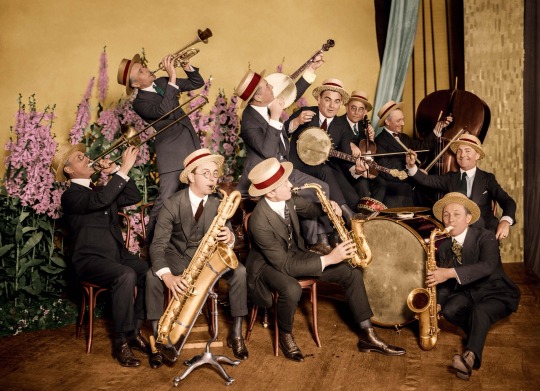
Art Hickman’s Orchestra, 1919
I’ve always really loved this novelty shot of the Hickman Orchestra, and I thought this fine colorization job by Mario Unger really brought a new life to it. The photo and colorization are the main attraction here, BUT I’m going to give some context as to who these guys are in case anyone is curious.
Hickman’s outfit is one of a couple 1910s dance bands that really laid the groundwork for what popular music would sound like in the 20s (and for what it’s worth, probably my personal favorite of that particular late-1910s style which I love so dearly). Hickman’s group was among the first popular bands to utilize a saxophone section, which was kind of a big moment for the trajectory of pop music and jazz in the first half of the 20th century. Their sound took the syncopated edge of contemporary “jass” and ragtime and infused that into a ballroom orchestra style. The resulting music carries itself with a refined and elegant air, but with a certain simmering rakishness underneath- and when these guys really dig into it, they play with an undeniable ragged verve. My favorite sides by them are probably Hesitating Blues and Cairo (both recorded 1919), however Hickman is probably best remembered by his 1917 composition Rose Room (named for the hotel ballroom at which they were the house band), which you still hear played often enough today (that is, if you’re in with the right scene). Would’ve loved to hear what this band sounded like live, I can only imagine that the old acoustic recordings don’t do them full justice.
#jazz age#vintage#vintage style#vintage music#1910s#1919#jazz banjo#hot jazz#jazz#1920s#Art Hickman#ragtime#jazz history#music history#photography#colorized#Rose Room#jazz music
23 notes
·
View notes
Text

Bill Evans within his apartment in Plainsfield, New Jersey, NY, 1980 (photography by Lynn Goldsmith)

1975
#history#vintage#bill evans#jazz#modern jazz#modern#modern music#modernism#transcription#transcriptions#bill evans 3#book#sheet music#1970s#1975#american music#composer#piano#pianist#20th century#twentieth century#20th century music#twentieth century music#article#interview#music history#jazz history#lynn goldsmith#photography#color photography
6 notes
·
View notes
Text
Paul Colin poster for French jazz bandleader Alix Combelle, 1935.

9 notes
·
View notes
Text
Jazz dreamin’
what would it have been like to be there to see and hear him in his prime? to smell the smoke, the liquor, smell the sweat of the crowd, ride the wave of the jazz notes that poured out…
Miles Davis performance at the Village Vanguard. New York, 1958.
Photo: Dennis Stock

3 notes
·
View notes
Text

Tony Bennett
#history#vintage#photography#musician#music#portrait#black and white photography#american history#italian american#italian american history#jazz#crooning#crooner#singer#singing#tony bennett#modern jazz#standards#performer#jazz musician#jazz singer#american#anerica#jazz history#u.s. history#u.s.#20th century history#20th century#twentieth century history#twentieth century
7 notes
·
View notes
Text
whoever made this caricature of cab calloway needs to be executed
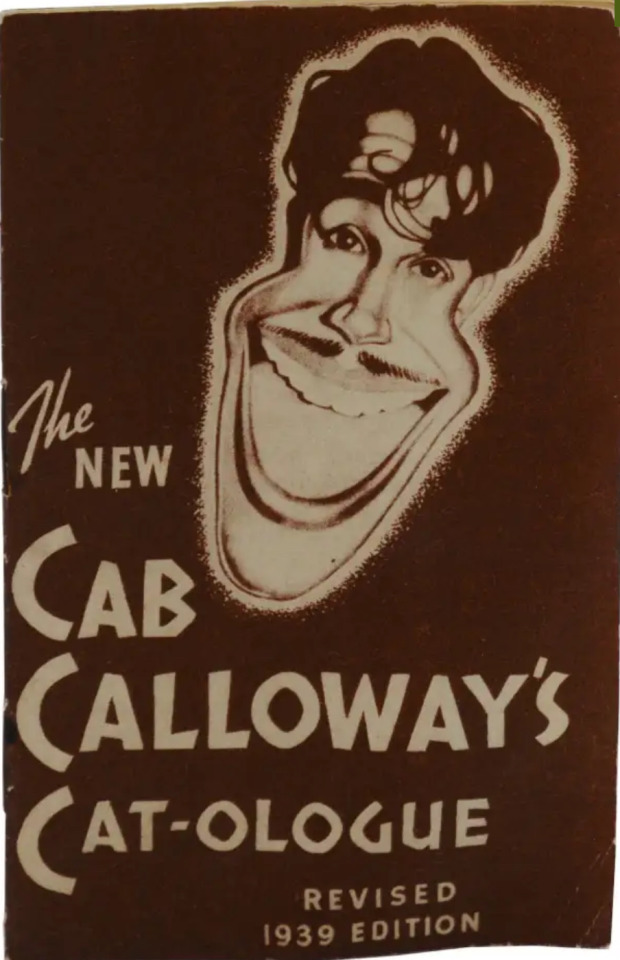
WHAT THE FUCK IS THIS
#cab calloway#jazz music#1930s#caricature#vintage#look how they massacred my boy#he looks like a buttplug what the hell#blues music#harlem renaissance#jazz history
3 notes
·
View notes
Text
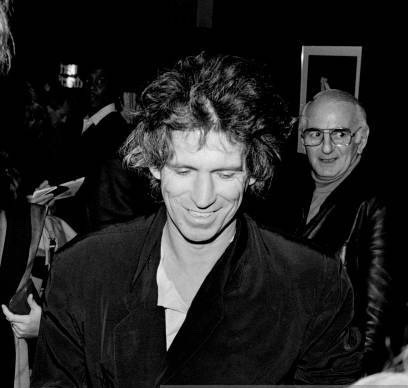
Keith Richards and Ronnie Scott attend a Charlie Watts Jazz Orchestra Show at the latter’s club (1985)
#I’m just in this for Ronnie#who honestly looks cooler than Keith here#and I love that he actually came to the show#it must have meant the world to Charlie#the rolling stones#charlie watts#keith richards#middle aged married band#ronnie scott#jazz#jazz history#london
28 notes
·
View notes
Text
instagram
Alice Coltrane and her husband ❤️🎷
#alice coltrane#jazz#jazz harp#jazz history#bebop#free jazz#spiritual jazz#music#1960s jazz#1960s music#1960s#john coltranes#coltrane#Instagram
4 notes
·
View notes
Text
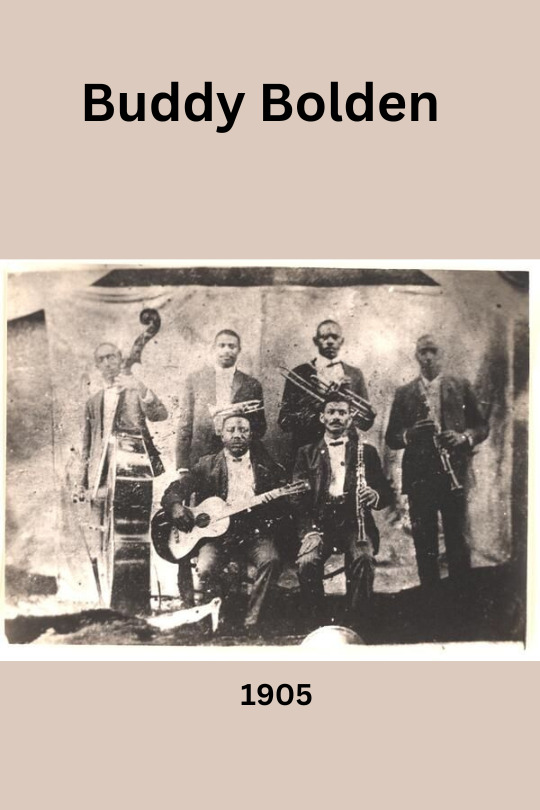
This is the only known photo of #BuddyBolden to exist, pictured with his band circa 1905. He is standing in the back row holding the cornet.
He is regarded as a key figure in the development of a New Orleans ragtime music, or "jass", later known as jazz.
Source: New Orleans Jazz Museum
8 notes
·
View notes
Text
On Aziraphale and “bebop:”
I’ve seen GO fans expressing confusion about Aziraphale’s animosity towards bebop, so I wanted to chime in about what I think is going on.
Bebop represented a sharp break from the more melodic big band/swing/dance orchestra styles of jazz that preceded it. It is a much more purely improvisational form of music, and it sounded jarring and discordant to people who were used to more traditional styles of jazz and pop. It was considered “musician’s music,” more designed to show off virtuosity than to be accessible to the listener.
Some of the older generation of jazz musicians were pretty hostile to bebop when it began to emerge in the early-mid 1940s. See, for example, the notorious clashes between Cab Calloway and Dizzy Gillespie when young Dizzy was cutting his teeth on the super edgy modern style during his time in Cab’s band. A lot of listeners must have reacted the same way at the time.
Aziraphale objects to bebop because it is jarring and new and bizarre to his ear. When your favorite “modern” music is stuff like the New Mayfair Dance Orchestra, bebop is going to sound weird as fuck. And because he is so slow to adapt to the way the world changes around him, any type of music from the last century or so that sounds jarring and new and weird to him (i.e., most of it) gets lumped into the category of “bebop.” It’s the eldritch immortal being equivalent of “Darn kids and their loud rock and roll music!”
26 notes
·
View notes
Text
"Light as a Feather:" A Landmark in Jazz Fusion
Introduction: The early 1970s was a transformative period for jazz. Artists sought to break free from traditional structures, exploring uncharted territories that incorporated elements of rock, world music, and experimental sounds. Among the many groundbreaking albums of this era, “Light as a Feather” by Return to Forever stands as a shining beacon of innovation and artistry. Released in January…
#1000 Recordings to Hear Before You Die#Airto Moreira#Chick Corea#Classic Albums#Concierto de Aranjuez#Flora Purim#Hymn of the Seventh Galaxy#Jazz History#Joaquín Rodrigo#Joe Farrell#Light as a Feather#Miles Davis#Neville Potter#Records to Die For#Return to Forever#Stan Getz#Stanley Clarke#The Absolute Sound#Tom Moon
6 notes
·
View notes
Text
As good as it Getz MAWS Blog #8
As Good as it Getz
Mel Martin in his article Stan Getz Musings interviews legendary Philly born saxophonist Stan Getz, on how he gets his sound (Joffe, 2020). Stan Getz recalls that when he played with famed jazz clarinetist, Benny Goodman, when he was eighteen that his time with him partially shaped his sound (Joffe, 2020). I always enjoyed Getz’ playing, with his superb sense of phrasing and melodicism. I am a big fan of Benny Goodman, he, apart from Pete Fountain, is the reason why I picked up clarinet and got into jazz as a genre in the first place. I believe the same reason I enjoy Stan Getz, even though he is a saxophonist, is that Benny Goodman always has a good sense of phrasing and melodicism, and that, maybe not consciously, but in a subconscious sense, must have informed Getz’ sounds, musical styling, lines, etc. What I like about Getz’ playing versus other saxophone players, is his tone and playing are so “smooth”. Getz in the interview confirms this, by his admission, when playing, he tried to get the “reediness” out from his playing with more emphasis on “breath” (Joffe, 2020). What is fascinating is one revelation Getz states that I had no idea about his playing. Getz plays mostly by ear, rather than by studied formal training (Joffe, 2020). While I do enjoy technicians who can read and write music, I have noticed that some of my favorite players/writer’s of music simply played by ear, played what sounded “good” to them. I think a lot of Jazz gets bogged down by modes, scales, etc. I noticed that, while yes having an understanding of music theory and composition can help immensely with a musicians progress, and understanding of music, it also perhaps takes the sense of feel, of the human element of playing. The great guitar player Jimi Hendrix, who some debate was the greatest of all time, could not read or write music, but rather played by ear. Some of his solos, while they could be wailing and noisy at times, had a sense of yearning, sadness, excitement, and anger, something that I don’t think is captured by studied musicians all the time. The Beatles are the perfect example of musicians who played by ear/who did not know music theory. A lot of there songs, while one could say are perfectly melodic, as well as have great harmony, will suddenly switch to three or four different time signatures in one song. Anyone with a sense of music theory would say they are writing songs wrong. But it is exactly these strange sudden time signature changes that propel/give a certain magic to The Beatles music.
Mel Martin’s article Stan Getz Musings gives insight to the musical mind of Stan Getz, with Getz’ own words. It is a very rare thing to get inside the brain of these musician’s minds, on how they play, their influences, what informed their style, what their thoughts are on the music they play. It seems that Getz had a keen self-awareness about himself, about his strengths, likes dislikes, influences, musical heroes, and weaknesses within himself. This understanding of how a musician’s mind works, especially within the context of jazz music, will aid in the questions I might ponder, and ultimately ask Philadelphian jazz musicians. I think this article gives great insight on how to produce a thoughtful interview with an artist. If thoughtful, researched, and appropriate questions are asked, I have a feeling it will yield great results to the podcast about Philadelphian Jazz, or at least, an upcoming rising star in the Philly Jazz scene.
For LinkedIn Learning I watched the course “Vocal Production for Voice-Overs and Podcasts” by Evan Sutton. I learned that according to Evan Sutton, using a dynamic microphone is the best type of microphone to use for voice-over/podcasting. Sutton specifically states that while a standard Shure 57, which is usually used for tracking guitars etc., can be used, that a Shure 7 would be the go-to mic for him when recording. Sutton states that when recording in a space, to have stuff to effect sound. If one does not have access to a vocal booth, one could use towels, or other sound dampening materials to effect room tone, and to limit reverberation. Sutton also mentions the importance of slating things and keeping reference to a timecode. I remember in Professor Zaylea’s class, Producing and Directing, that when my classmate and I were shooting our short film, we had to be cognizant of sound. We were fortunate to have one of our classmate’s friends, Rockwell Valentine, make sure that the sounds levels were good, that for each take a slate in the form of handclaps were used. For each take Rockwell would make sure that the levels were good in the zoom recorder. Rockwell also would shout at the start of recording the scene that the sound was taking place, and what take it was. The directors of the short film, Riley Flanagan and Robb Konczyk would also perform hand claps and state the scene and take for both audio and video as well. This helped for editing later, to not add confusion to the myriad of both video and audio footage we recorded during the shooting sessions.
Works Cited
Joffe, E. (2020, October). Stan Getz Musings - Joffe Woodwinds. Joffe Woodwinds. https://www.joffewoodwinds.com/articles/stan-getz-musings/
Sutton, E. (2022, March 7). DAW setup and parameters - Logic pro video tutorial | LinkedIn learning, formerly Lynda.com. LinkedIn. https://www.linkedin.com/learning/vocal-production-for-voice-overs-and-podcasts/daw-setup-and-parameters?autoSkip=true&resume=false
#podcast#jazz#jazzmusic#project#temple university#jazz history#philadelphia#philly#soundcloud#stan getz#saxophone#benny goodman#clarinet
2 notes
·
View notes
Text
youtube
#bill evans#jazz#modern jazz#piano#pianist#composer#jazz pianist#essay#writing#american music#american musicians#american jazz#music history#jazz history#20th century music#nardis#youtube#video#link#article#20th century#twentieth century#twentieth century music#1970s#1979#paris#paris france#france#bill evans trio#Youtube
2 notes
·
View notes